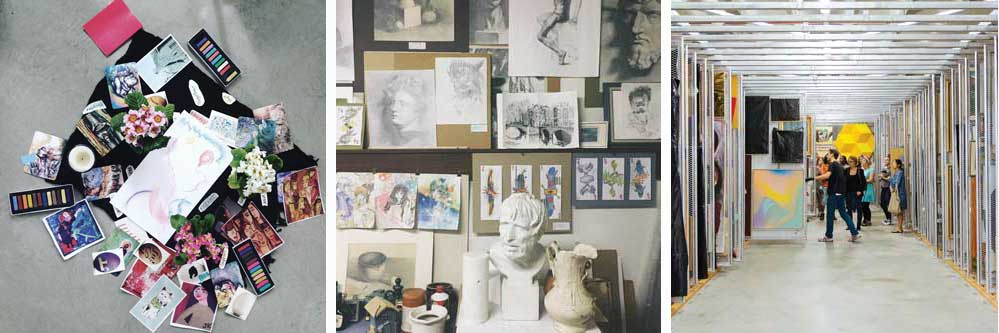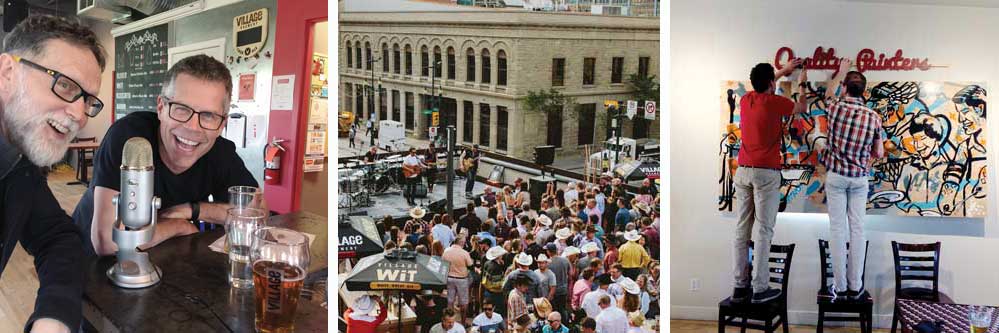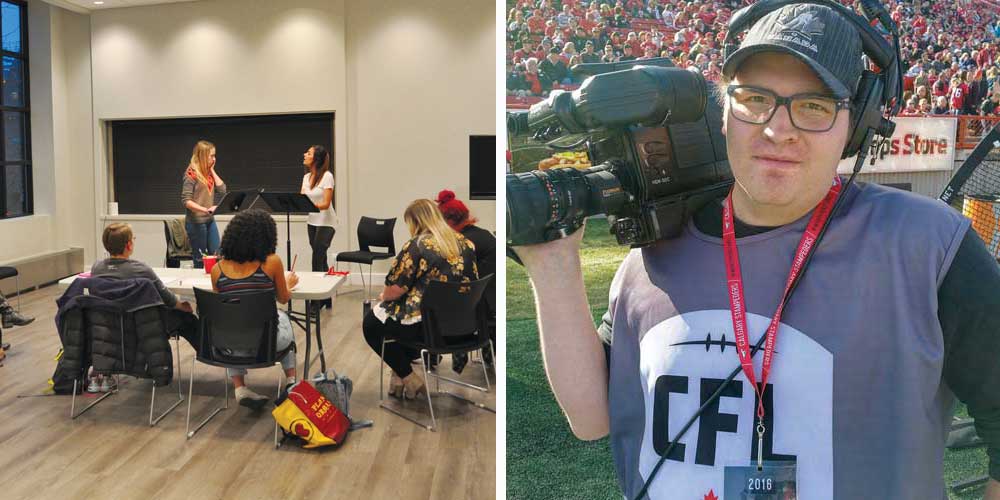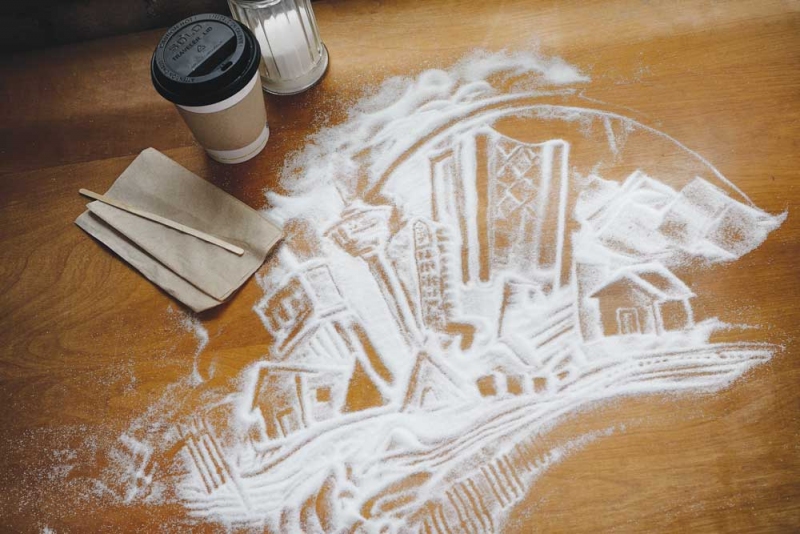Over the past year, Stephen Hunt has come to know a lot of interesting Calgarians. The freelance writer has been interviewing dozens of locals, from 12-year-old robot builders to lifelong street musicians, and writing profiles of them for The Storytelling Project, which spot-lights people who are forging their own path in new and creative ways.
The Storytelling Project is part of a larger initiative, Living A Creative Life (LCL), created by Calgary Arts Development Authority (CADA) in 2014. So far, Hunt estimates he has written more than three dozen profiles for CADA’s website. “You always sort of wonder if we’re going to run out of people to write about, and then you come up with a whole bunch of new people who live their lives in unconventional, creative ways,” he says. “Calgarians keep surprising me.”
Among Hunt’s favourite profiles is Karen Anderson, who started Calgary Food Tours in 2006 after more than two decades working as a nurse. Her journey to become an advocate for Calgary’s food scene paralleled Calgary’s emergence as an up-and-coming food city, says Hunt. Another person he loved writing about is Lori Beattie, author of the books Calgary’s Best Bike Rides and Trails and Calgary’s Best Walks, who encourages people to explore the city with the kind of adventurous spirit that they would have for the mountain areas.
The people Hunt profiles for CADA aren’t necessarily artists – but their approach to life is in and of itself creative, which is what the LCL tries to promote. “They’re defining how they want to live their lives according to their own preferences and passions, rather than trying to adopt a template that they saw on television or in a magazine,” says Hunt.
LCL doesn’t give out grants, sponsor artists or create projects (aside from The Storytelling Project). Instead, according to CADA’s Patti Pon, it seeks to galvanize the multitude of creative resources already out there by raising awareness of them, so that the creativity of everyday lives can serve as inspiration, helping people to realize that everyone can contribute to the vitality of the city by living their own creative life. “Part of living a creative life is actual, intentional awareness that you are an example,” says Pon. “We all have our role to play in contributing to building this city.”

(Right) Living a Creative Life’s photo of the month for April 2017 (selected from the pool of Instagram shots with the hashtag #yycLCL) by Rachel Rose. (Middle) Photo of the month for January 2017 by Dillon (Ding-Chao) Huang. (Left) Photo of the month for November 2016 by Andy Nichols.
One way LCL raises awareness is by asking local businesses and organizations that embody its principles to become signatories to the initiative. These signatory organizations agree to contribute in their own way to making Calgary a more connected place through their creative endeavours, hopefully inspiring others to follow suit.
Calgary’s Village Brewery counts itself among the LCL signatories and has since been inspired to dust off its Village Radio program. The brewery had shelved the podcast, in which local celebrity host Dave Kelly interviews inspiring Calgarians over beers, in 2015. “Signing and having the conversation with [CADA] reminded us that we have the responsibility to bring that thing back,” says Village co-founder Jim Button. The episodes now pull double duty as a Village initiative as well as adding to The Storytelling Project. At the time of writing, the podcast had more than 75 episodes and 200,000 downloads. “Its purpose is to find, share and celebrate those great stories of people doing things in the city,” says Button. “It’s important that other people say, ‘Wow, that’s in Calgary? I’m inspired by that. I’m going to do that.'”
According to Button, creativity is an essential ingredient in Village’s brews. “Beer is just ingredients, time and temperature, but if you took
the exact same ingredients and gave them to 100 brewers, they could come up with hundreds of thousands of styles of beer,” he says. “It’s a very creative process – not only in the course of making it, but in how you distribute it, how you package it, how you sell it and how you use it to support the arts community.”
Button says he believes the arts are the backbone of society and he wants to live out that belief as much as possible, which is why Village signed the LCL. “It’s a reminder of why we are a brewery and why we do what we do every day. Being a signatory is yet another one of those things you put on a wall, so that people go, ‘Right, that’s who we are, that’s what we’re supposed to be doing,'” he says. “Without people living their creative lives, [the city] would quickly become stagnant, boring and a lousy place to live.”
Village also has a stake in the arts community through sponsorships of events like Reggaefest and Blues Fest, in addition to co-founding an annual gathering of food trucks with musical performances and other live entertainment. (Formerly known as the Circle the Wagons Festival, this year’s event on Sept. 9 will include the announcement of a new name for the festival, to be more inclusive of all communities.) Village also created a gallery space at its Calgary production headquarters and each year invites artists in to display and sell their work.
While Village Brewery exemplifies the breadth of the term “creative” in its processes, community outreach and side projects, other signatories to the LCL are more traditional in their approach.

(Right) Village Brewery’s Jim Button and host Dave Kelly recording for Village Radio. (Middle) A Village Brewery-sponsored event in downtown Calgary. (Left) Village Brewery’s gallery space.
One of the first groups to sign on to LCL was the Calgary Board of Education (CBE). At the time the group signed on, Julie Barton,
a fine-arts off-campus specialist with the CBE, co-chaired a fine-arts advisory committee within the CBE. Barton says at that time some sections of the arts curriculum hadn’t been updated in nearly three decades. “There was no film studies, there was nothing digital, and dance didn’t exist, except as a sport. There were some real concerns.
“The [provincial] government asked us to prototype what arts education might look like, so one of our first actions was getting our arts community together with CADA. They brought us together in a summit and we started to ask ourselves, ‘What is arts education?'”
One of the conclusions drawn from the summit was that students needed hands-on programs where they could create their own
art and interact with artists in authentic ways rather than just by listening to them. This realization, says Barton, was a huge turning point for both the CBE and its art partners.
Barton points to new collaborations with groups such as the Royal Conservatory of Music, Calgary Opera and Alberta Theatre Projects, where they have partnered to develop a model of learning based on students being participants, rather than spectators. “One of the great things about this is our community has learned the great capacity of our kids,” says Barton. “In the past, where [the students] would have sat and watched, they’re now actually writing scripts, they’re producing productions, they’re working with and alongside people in the creative industries.”
One of the CBE’s goals after signing the LCL was to pursue research in related areas of interest. One such area is socially empowered learning, which is group-based learning that allows students to take a hands-on approach, creating videos or writing plays, for example, that address weighty subject matter such as environmental and human-rights issues. One example of this is Kids Go Global, a partnership between schools, non-government organizations and local children’s theatre company Trickster Theatre. In the program, kids from kindergarten through grade 12 have an opportunity to learn about everything from disaster relief to the importance of water and create media about what they’ve learned.
Research into socially empowered learning conducted by the Rozsa Foundation found that there is an increase in intellectual engagement, social empowerment and entrepreneurial spirit when arts are integrated into a program. The research also found that English-as-second-language learners scored higher on intellectual engagement in arts-based programs than children whose first language was English.

(Right) Representatives from Alberta Theatre Projects working with students from the Calgary Board of Education’s Fresh Prints playwriting program. (Left) A former participant in the AAFS movie-project program who went on to a career in sports broadcasting.
Similarly, creative approaches have greatly benefitted the kids at the Autism Aspergers Friendship Society of Calgary (AAFS). The AAFS is dedicated to helping those with autism and Asperger’s syndrome lead fulfilling lives through its programming.
AAFS founder Dean Svoboda believes that creative outlets like film and music can provide kids with ways to engage with the community.
“A lot of folks with autism, they just think differently, and sometimes through therapies some of those creative ways of thinking or being can be limited, taken away or prevented,” says Svoboda. “We really encourage our kids to think for themselves, express themselves, be creative and go with their ideas.”
At AAFS, creativity is used all the time in trying new approaches to engaging kids, such as getting them involved in martial arts or creating a space for them to hang out and plan activities on Friday nights. Some of the ways AAFS encourages the kids in its programs is through workshops such as a journalism program, where participants create the MagAAFSzine, an in-house publication that includes everything from short stories and interviews to comic strips. Another successful endeavour, which began in 2010, is AAFS’s movie program, where members learn about storytelling, collaborate on making movies and express themselves through film.
The society also has programs covering visual arts, parkour, tae kwon do and new media. “It’s about different environments, different people, different experiences and being open to those things” says Svoboda. “A lot of what we do is teaching our kids to engage in new environments, which can be difficult for a lot of them.”
The advantage of working with the arts, says Svoboda, is that the communities are very accepting of differences. Being a signatory to the Living A Creative Life strategy means they can provide an example to others of how to better integrate creativity into their lives. “Being able to express each individual’s idea of living a creative life, and to get that idea out there [is vital]. We all should be living creative lives to our fullest capacity, whether that’s being a professional artist, or learning how to put Lego blocks together to make a sculpture. Everybody needs that creativity.”
One of Svoboda’s favourite AAFS success stories features a boy named Anton. “He was told throughout life he would never graduate, he would never really write, he probably wouldn’t drive,” Svoboda says. Growing up, Anton loved sports and going to the Saddledome. He was particularly fascinated by the bank of cameras at the arena and took in every detail of how they worked. He was able to take his interest in cameras and filming further through AAFS’s movie-project program, and parlayed that into a spot in Mount Royal’s broadcasting program. Anton has since graduated from the broadcasting program and now works for the Calgary Flames on their cameras.
“One of the big inspirations for our youth is to say, ‘At one time, Anton was just a guy like you, with a lot of these challenges; he’s overcome them and so can you,'” says Svoboda.
While it may not be immediately clear, LCL proposes that there is a through line from the experience of someone like Karen Anderson to Anton. They are each one of a multitude of Calgarians whose lives have been changed thanks to creativity and creative approaches to living, and those changes in themselves have a positive effect on others as well.
From CADA’s perspective, this ripple effect is one of the more important results of living a creative life – inspiring others in the community and helping them dip their toes into living a more creative life. Says Button: “You’ll be amazed at how that one step of creativity opens up your mind to a whole pile of different activities, thoughts, emotions, people and opportunities.”
11 Ways to Kick Start Your Creative Life
[Correction: The original version of this story had the credits for Living a Creative Life Instagram photo of the month in the incorrect order. This version is updated with the proper credits.]

